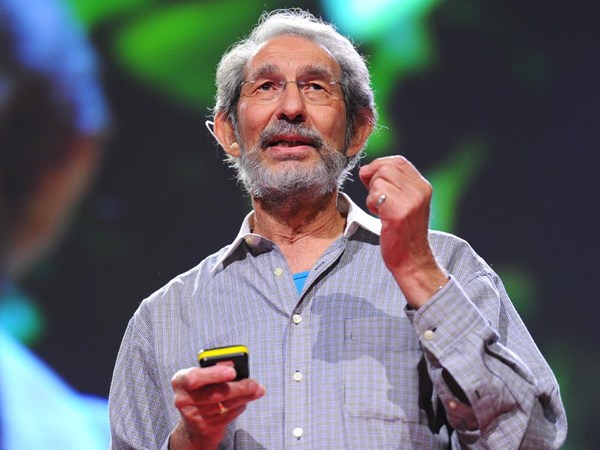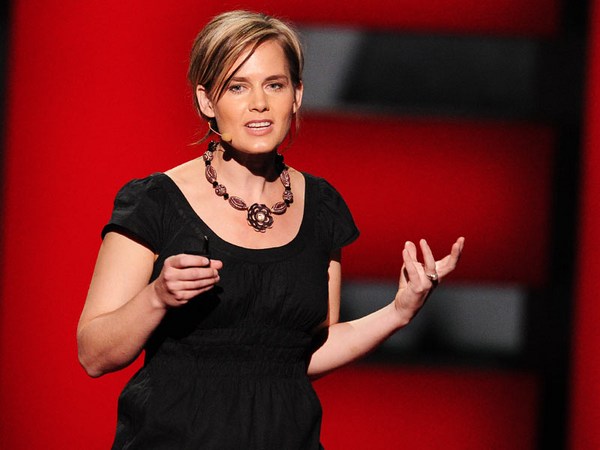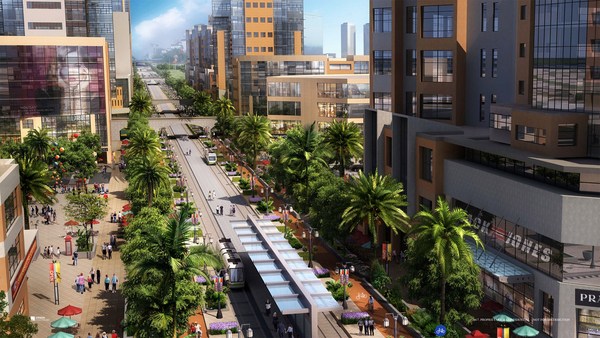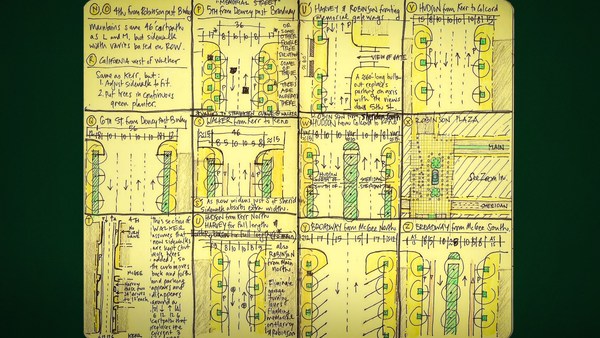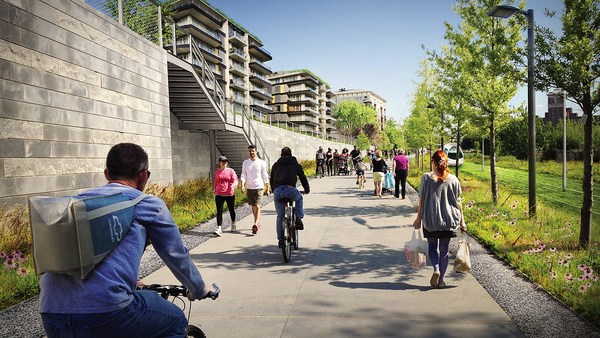I thought I would start with a very brief history of cities. Settlements typically began with people clustered around a well, and the size of that settlement was roughly the distance you could walk with a pot of water on your head. In fact, if you fly over Germany, for example, and you look down and you see these hundreds of little villages, they're all about a mile apart. You needed easy access to the fields. And for hundreds, even thousands of years, the home was really the center of life. Life was very small for most people. It was a center of entertainment, of energy production, of work, a center of health care. That's where babies were born and people died.
Then, with industrialization, everything started to become centralized. You had dirty factories that were moved to the outskirts of cities. Production was centralized in assembly plants. You had centralized energy production. Learning took place in schools. Health care took place in hospitals. And then you had networks that developed. You had water, sewer networks that allowed for this kind of unchecked expansion. You had separated functions, increasingly. You had rail networks that connected residential, industrial, commercial areas. You had auto networks. In fact, the model was really, give everybody a car, build roads to everything, and give people a place to park when they get there. It was not a very functional model. And we still live in that world, and this is what we end up with.
So you have the sprawl of LA, the sprawl of Mexico City. You have these unbelievable new cities in China, which you might call tower sprawl. They're all building cities on the model that we invented in the '50s and '60s, which is really obsolete, I would argue, and there are hundreds and hundreds of new cities that are being planned all over the world. In China alone, 300 million people, some say 400 million people, will move to the city over the next 15 years. That means building the equivalent of the entire built infrastructure of the US in 15 years. Imagine that.
And we should all care about this whether you live in cities or not. Cities will account for 90 percent of the population growth, 80 percent of the global CO2, 75 percent of energy use, but at the same time it's where people want to be, increasingly. More than half the people now in the world live in cities, and that will just continue to escalate.
Cities are places of celebration, personal expression. You have the flash mobs of pillow fights that -- I've been to a couple. They're quite fun. You have --
(Laughter)
Cities are where most of the wealth is created, and particularly in the developing world, it's where women find opportunities. That's a lot of the reason why cities are growing very quickly.
Now there's some trends that will impact cities. First of all, work is becoming distributed and mobile. The office building is basically obsolete for doing private work. The home, once again, because of distributed computation -- Communication is becoming a center of life, so it's a center of production and learning and shopping and health care and all of these things that we used to think of as taking place outside of the home.
And increasingly, everything that people buy, every consumer product, in one way or another, can be personalized. And that's a very important trend to think about.
So this is my image of the city of the future.
(Laughter)
In that it's a place for people, you know. Maybe not the way people dress, but -- You know, the question now is, how can we have all the good things that we identify with cities without all the bad things?
This is Bangalore. It took me a couple of hours to get a few miles in Bangalore last year. So with cities, you also have congestion and pollution and disease and all these negative things. How can we have the good stuff without the bad?
So we went back and started looking at the great cities that evolved before the cars. Paris was a series of these little villages that came together, and you still see that structure today. The 20 arrondissements of Paris are these little neighborhoods. Most of what people need in life can be within a five- or 10-minute walk. And if you look at the data, when you have that kind of a structure, you get a very even distribution of the shops and the physicians and the pharmacies and the cafes in Paris. And then you look at cities that evolved after the automobile, and it's not that kind of a pattern. There's very little that's within a five-minute walk of most areas of places like Pittsburgh. Not to pick on Pittsburgh, but most American cities really have evolved this way.
So we said, well, let's look at new cities, and we're involved in a couple of new city projects in China. So we said, let's start with that neighborhood cell. We think of it as a compact urban cell. So provide most of what most people want within that 20-minute walk. This can also be a resilient electrical microgrid, community heating, power, communication networks, etc. can be concentrated there. Stewart Brand would put a micronuclear reactor right in the center, probably. And he might be right. And then we can form, in effect, a mesh network. It's something of an Internet typology pattern, so you can have a series of these neighborhoods. You can dial up the density -- about 20,000 people per cell, if it's Cambridge. Go up to 50,000 if it's Manhattan density. You connect everything with mass transit and you provide most of what most people need within that neighborhood. You can begin to develop a whole typology of streetscapes and the vehicles that can go on them. I won't go through all of them. I'll just show one.
This is Boulder. It's a great example of kind of a mobility parkway, a superhighway for joggers and bicyclists, where you can go from one end of the city to the other without crossing the street, and they also have bike-sharing, which I'll get into in a minute.
This is even a more interesting solution in Seoul, Korea. They took the elevated highway, they got rid of it, they reclaimed the street, the river down below, below the street, and you can go from one end of Seoul to the other without crossing a pathway for cars.
The High Line in Manhattan is very similar. You have these rapidly emerging bike lanes all over the world. I lived in Manhattan for 15 years. I went back a couple of weekends ago, took this photograph of these fabulous new bike lanes that they have installed. They're still not to where Copenhagen is, where something like 42 percent of the trips within the city are by bicycle. It's mostly just because they have fantastic infrastructure there.
We actually did exactly the wrong thing in Boston. The Big Dig --
(Laughter)
So we got rid of the highway but we created a traffic island, and it's certainly not a mobility pathway for anything other than cars.
Mobility on demand is something we've been thinking about, so we think we need an ecosystem of these shared-use vehicles connected to mass transit. These are some of the vehicles that we've been working on. But shared use is really key. If you share a vehicle, you can have at least four people use one vehicle, as opposed to one. We have Hubway here in Boston, the Vélib' system in Paris.
We've been developing, at the Media Lab, this little city car that is optimized for shared use in cities. We got rid of all the useless things like engines and transmissions. We moved everything to the wheels, so you have the drive motor, the steering motor, the breaking -- all in the wheel. That left the chassis unencumbered, so you can do things like fold, so you can fold this little vehicle up to occupy a tiny little footprint.
This was a video that was on European television last week showing the Spanish Minister of Industry driving this little vehicle, and when it's folded, it can spin. You don't need reverse. You don't need parallel parking. You just spin and go directly in.
(Laughter)
So we've been working with a company to commercialize this. My PhD student Ryan Chin presented these early ideas two years ago at a TEDx conference.
So what's interesting is, then if you begin to add new things to it, like autonomy, you get out of the car, you park at your destination, you pat it on the butt, it goes and it parks itself, it charges itself, and you can get something like seven times as many vehicles in a given area as conventional cars, and we think this is the future. Actually, we could do this today. It's not really a problem. We can combine shared use and folding and autonomy and we get something like 28 times the land utilization with that kind of strategy.
One of our graduate students then says, well, how does a driverless car communicate with pedestrians? You have nobody to make eye contact with. You don't know if it's going to run you over. So he's developing strategies so the vehicle can communicate with pedestrians, so --
(Laughter)
So the headlights are eyeballs, the pupils can dilate, we have directional audio, we can throw sound directly at people. What I love about this project is he solved a problem that doesn't exist yet, so --
(Laughter)
We also think that we can democratize access to bike lanes. You know, bike lanes are mostly used by young guys in stretchy pants. So --
(Laughter)
We think we can develop a vehicle that operates on bike lanes, accessible to elderly and disabled, women in skirts, businesspeople, and address the issues of energy congestion, mobility, aging and obesity simultaneously. That's our challenge.
This is an early design for this little three-wheel. It's an electronic bike. You have to pedal to operate it in a bike lane, but if you're an older person, that's a switch. If you're a healthy person, you might have to work really hard to go fast. You can dial in 40 calories going into work and 500 going home, when you can take a shower. We hope to have that built this fall.
Housing is another area where we can really improve. Mayor Menino in Boston says lack of affordable housing for young people is one of the biggest problems the city faces. Developers say, OK, we'll build little teeny apartments. People say, we don't really want to live in a little teeny conventional apartment. So we're saying, let's build a standardized chassis, much like our car. Let's bring advanced technology into the apartment, technology-enabled infill, give people the tools within this open-loft chassis to go through a process of defining what their needs and values and activities are, and then a matching algorithm will match a unique assembly of integrated infill components, furniture, and cabinetry, that are personalized to that individual, and they give them the tools to go through the process and to refine it, and it's something like working with an architect, where the dialogue starts when you give an alternative to a person to react to.
Now, the most interesting implementation of that for us is when you can begin to have robotic walls, so your space can convert from exercise to a workplace, if you run a virtual company. You have guests over, you have two guest rooms that are developed. You have a conventional one-bedroom arrangement when you need it. Maybe that's most of the time. You have a dinner party. The table folds out to fit 16 people in otherwise a conventional one-bedroom, or maybe you want a dance studio. I mean, architects have been thinking about these ideas for a long time. What we need to do now, develop things that can scale to those 300 million Chinese people that would like to live in the city, and very comfortably. We think we can make a very small apartment that functions as if it's twice as big by utilizing these strategies. I don't believe in smart homes. That's sort of a bogus concept. I think you have to build dumb homes and put smart stuff in it.
(Laughter)
And so we've been working on a chassis of the wall itself. You know, standardized platform with the motors and the battery when it operates, little solenoids that will lock it in place and get low-voltage power. We think this can all be standardized, and then people can personalize the stuff that goes into that wall, and like the car, we can integrate all kinds of sensing to be aware of human activity, so if there's a baby or a puppy in the way, you won't have a problem.
(Laughter)
So the developers say, well, this is great. OK, so if we have a conventional building, we have a fixed envelope, maybe we can put in 14 units. If they function as if they're twice as big, we can get 28 units in. That means twice as much parking, though. Parking's really expensive. It's about 70,000 dollars per space to build a conventional parking spot inside a building. So if you can have folding and autonomy, you can do that in one-seventh of the space. That goes down to 10,000 dollars per car, just for the cost of the parking. You add shared use, and you can even go further.
We can also integrate all kinds of advanced technology through this process. There's a path to market for innovative companies to bring technology into the home. In this case, a project we're doing with Siemens. We have sensors on all the furniture, all the infill, that understands where people are and what they're doing. Blue light is very efficient, so we have these tunable 24-bit LED lighting fixtures. It recognizes where the person is, what they're doing, fills out the light when necessary to full spectrum white light, and saves maybe 30, 40 percent in energy consumption, we think, over even conventional state-of-the-art lighting systems. This just shows you the data that comes from the sensors that are embedded in the furniture. We don't really believe in cameras to do things in homes. We think these little wireless sensors are more effective.
We think we can also personalize sunlight. That's sort of the ultimate personalization in some ways. So we've looked at articulating mirrors of the facade that can throw shafts of sunlight anywhere into the space, therefore allowing you to shade most of the glass on a hot day like today. In this case, she picks up her phone, she can map food preparation at the kitchen island to a particular location of sunlight. An algorithm will keep it in that location as long as she's engaged in that activity. This can be combined with LED lighting as well.
We think workplaces should be shared. I mean, this is really the workplace of the future, I think. This is Starbucks, you know. Maybe a third -- And you see everybody has their back to the wall and they have food and coffee down the way and they're in their own little personal bubble. We need shared spaces for interaction and collaboration. We're not doing a very good job with that. At the Cambridge Innovation Center, you can have shared desks. I've spent a lot of time in Finland at the design factory of Aalto University, where the they have a shared shop and shared fab lab, shared quiet spaces, electronics spaces, recreation places.
We think ultimately, all of this stuff can come together, a new model for mobility, a new model for housing, a new model for how we live and work, a path to market for advanced technologies. But in the end, the main thing we need to focus on are people. Cities are all about people. They're places for people. There's no reason why we can't dramatically improve the livability and creativity of cities like they've done in Melbourne with the laneways while at the same time dramatically reducing CO2 and energy. It's a global imperative. We have to get this right.
Thank you.
(Applause)

